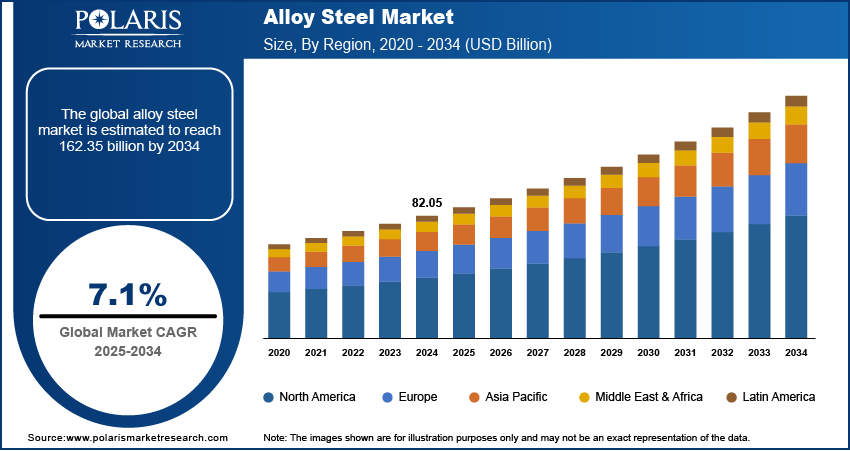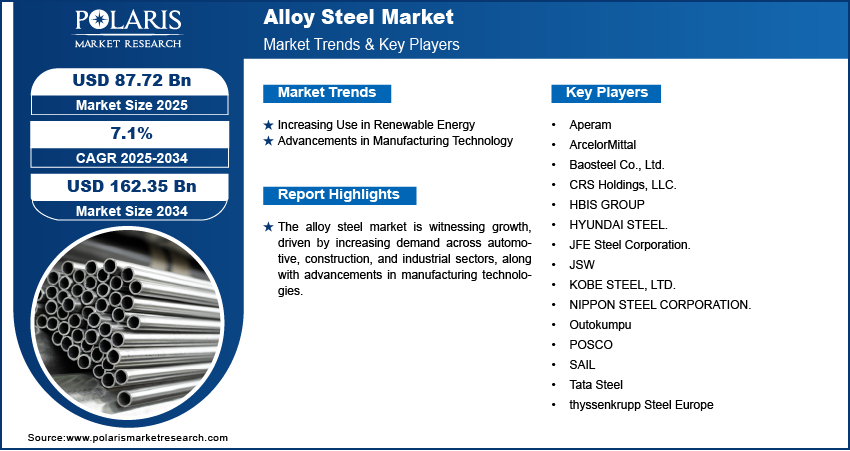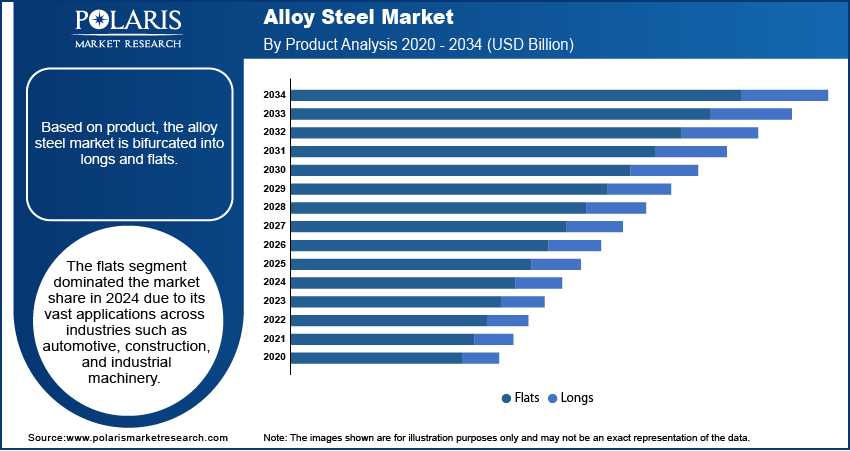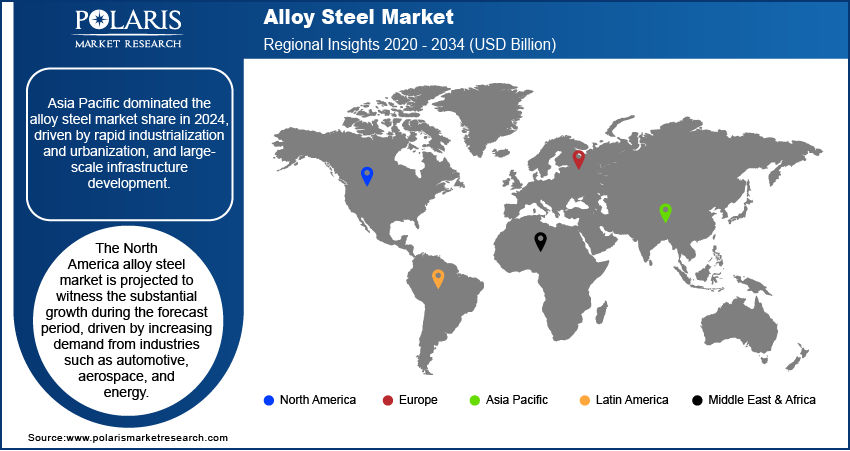
Alloy Steel Market Size, Share, Trends, Industry Analysis Report: By Product (Flats and Longs), Type, End Use, and Region (North America, Europe, Asia Pacific, Latin America, and Middle East & Africa) – Market Forecast, 2025–2034
- Published Date:Apr-2025
- Pages: 129
- Format: PDF
- Report ID: PM5465
- Base Year: 2024
- Historical Data: 2020-2023
Alloy Steel Market Overview
The global alloy steel market size was valued at USD 82.05 billion in 2024. It is expected to grow from USD 87.72 billion in 2025 to USD 162.35 billion by 2034, at a CAGR of 7.1% during 2025–2034.
Alloy steel, a type of steel enhanced with various elements to improve its mechanical properties, plays a crucial role in numerous industries due to its superior strength, durability, and resistance to wear. One of the major drivers of the alloy steel market growth is the growing demand from the automotive sector. Automakers are increasingly utilizing alloy steel in vehicle manufacturing to improve fuel efficiency, reduce weight, and improve safety. For instance, in February 2021, Vedanta Limited launched cylinder head alloy, an essential material for automotive components, improving engine efficiency and emission control to meet BS-VI and CAFE norms. Previously, India relied entirely on imports for this alloy. The material’s high strength-to-weight ratio makes it ideal for components such as engine parts, chassis, and transmission systems. Additionally, the shift toward electric vehicles (EVs) has accelerated the demand for advanced alloy steel grades that support lightweight structures without compromising performance.

To Understand More About this Research: Request a Free Sample Report
Another driver is the expansion of the construction and infrastructure sector, which heavily relies on alloy steel for structural applications. The demand for high-strength steel in bridges, buildings, and transportation networks continues to rise with rapid urbanization and large-scale infrastructure projects. Alloy steel's superior resistance to corrosion and environmental stress makes it a preferred choice for critical construction elements, assuring longevity and structural integrity. Furthermore, government investments in smart cities and sustainable infrastructure development are contributing to the increased adoption of alloy steel, reinforcing its importance in modern engineering and architectural applications. According to a September 2024 Invest India report, India is developing 12 new industrial smart cities under the NICDP, aiming to create hubs of industry and innovation with an investment of USD 3.43 billion.
Alloy Steel Market Dynamics
Increasing Use in Renewable Energy
The increasing use of alloy steel in renewable energy applications is a major driver of alloy steel market development, driven by the sector’s need for durable and high-performance materials. This is further supported by government initiatives promoting clean energy and sustainable infrastructure. For instance, in March 2024, the Union Minister launched India’s first Green Hydrogen Plant in the stainless steel sector at Jindal Stainless, Hisar. The project, using rooftop and floating solar, aims to cut 2,700 MT of carbon emissions annually, supporting India’s net-zero goals. Such advancements highlight the critical role of alloy steel in enabling renewable energy solutions. Wind turbines, solar power structures, and hydroelectric plants require components that can withstand extreme environmental conditions, making alloy steel an essential material due to its high strength, corrosion resistance, and longevity. In wind energy, alloy steel is widely used in turbine towers, gears, and bearings to enhance operational efficiency and durability. Similarly, solar panel mounting structures and hydroelectric dam reinforcements rely on advanced steel alloys for structural integrity. Therefore, as the global transition to clean energy accelerates, the demand for high-quality alloy steel continues to grow, supporting the expansion of renewable energy infrastructure.
Advancements in Manufacturing Technology
Innovations such as precision alloying, advanced heat treatment processes, and automation in steel manufacturing have improved the material’s strength, toughness, and machinability. For instance, in June 2023, Cummins Inc. and Oak Ridge National Laboratory developed a high-temperature steel alloy, improving engine durability and efficiency. The alloy outperforms 4140 steel, with 85% greater tensile strength and 143% higher fatigue strength at 600°C, supported by DOE’s LightMAT Program. These technological improvements optimize production costs and also expand the application range of alloy steel across various industries, such as automotive, aerospace, and heavy machinery allowing the production of higher-performance steel grades with improved efficiency. Additionally, the integration of artificial intelligence and data-driven quality control systems has improved consistency in alloy composition and performance, further driving the adoption of alloy steel in modern engineering applications.

Alloy Steel Market Segment Insights
Alloy Steel Market Assessment by Product Outlook
The global alloy steel market segmentation, based on product, includes longs and flats. The flats segment dominated the alloy steel market revenue share in 2024 due to its vast applications across industries such as automotive, construction, and industrial machinery. Flat products, such as sheets, plates, and coils, offer superior versatility, strength, and ease of fabrication, making them essential for structural components and high-performance equipment. The growing demand for lightweight and durable materials in the automotive sector, coupled with increased infrastructure development, has driven the adoption of flat alloy steel products. Additionally, advancements in manufacturing processes have allowed the production of high-quality flat steel with improved mechanical properties, further solidifying the dominating segment share.
Alloy Steel Market Evaluation by Type Outlook
The global alloy steel market segmentation, based on type, includes low alloy and high alloy. The high alloy segment is expected to witness the fastest growth during the forecast period due to its superior strength, corrosion resistance, and high-temperature performance. High alloy steel, which contains a considerable proportion of elements such as chromium, nickel, and molybdenum, is widely used in industries requiring extreme durability, including aerospace, energy, and chemical processing. The increasing adoption of stainless steel, a high alloy variant, in critical applications such as medical equipment and renewable energy infrastructure is further fueling alloy steel market demand. Additionally, advancements in metallurgical technologies have improved the performance and efficiency of high alloy steels, making them a preferred choice for advanced engineering applications.

Alloy Steel Market Regional Analysis
By region, the report provides the alloy steel market insights into North America, Europe, Asia Pacific, Latin America, and the Middle East & Africa. Asia Pacific dominated the alloy steel market share in 2024, driven by rapid industrialization and urbanization, and large-scale infrastructure development. Countries such as China, India, and Japan have witnessed significant growth in the construction, automotive, and manufacturing sectors, all of which rely heavily on alloy steel. The region's strong presence of steel manufacturers and continuous investments in modernizing production facilities have further supported alloy steel market expansion in the region. In February 2024, JFE Steel and JSW Steel established JSW JFE Electrical Steel Private Limited, a joint venture to produce grain-oriented electrical steel in India and to expand production. Additionally, the rising demand for high-performance materials in sectors such as renewable energy and transportation has contributed to Asia Pacific's leadership in alloy steel consumption. Government initiatives promoting domestic steel production and infrastructure development have further reinforced the region’s dominance in the market. According to a November 2024 report by the IBEF, the Ministry of Steel is establishing the Steel Research and Technology Mission of India (SRTMI), a USD 30 million initiative, in collaboration with public and private steel companies to drive R&D in the iron & steel industry.
The North America alloy steel market size is projected to witness a substantial growth during the forecast period driven by increasing demand from industries such as automotive, aerospace, and energy. The region's focus on advanced manufacturing techniques, such as automation and precision alloying, has allowed the production of high-quality alloy steel with improved properties. This is clear in recent large-scale investments aimed at improving sustainable and efficient steel production. In February 2022, US Steel began construction of a USD 3 billion advanced steel mill in Osceola, Arkansas, which is part of Big River Steel Works and is expected to greatly improve sustainable steel production capabilities. Such initiatives highlight the region's commitment to innovation and sustainability. Additionally, the shift towards electric vehicles and sustainable infrastructure development is boosting the demand for lightweight and high-strength steel components. The presence of leading aerospace and defense manufacturers, coupled with rising investments in renewable energy projects, is further driving the North America alloy steel market expansion. North America's commitment to technological advancements and material innovation is expected to play a crucial role in the market growth.

Alloy Steel Key Market Players & Competitive Analysis Report
The competitive landscape combines global leaders and regional players competing to capture alloy steel market share through innovation, strategic alliances, and regional expansion. Global players such as ArcelorMittal, POSCO, Nippon Steel Corporation, and others leverage robust R&D capabilities and extensive distribution networks to deliver advanced high-performance alloys, specialty grades, and value-added steel products. Alloy steel market trends indicate rising demand for solutions, such as high-strength, low-alloy steels, and advanced high-strength steels, reflecting advancements in metallurgical science and manufacturing techniques. According to alloy steel market statistics, the market is projected to grow, driven by increasing applications in the automotive, construction, aerospace, and energy sectors. Regional companies capitalize on localized needs by offering cost-effective and tailored products, especially in emerging markets. Competitive market strategy includes mergers and acquisitions, partnerships with industrial manufacturers, and the introduction of innovative alloy formulations to address the growing demand for lightweight, durable, and high-performance materials. These developments underline the role of technological innovation, market adaptability, and regional investments in driving the alloy steel industry expansion. A few key players are Aperam; ArcelorMittal; Baosteel Co., Ltd.; CRS Holdings, LLC.; HBIS GROUP; HYUNDAI STEEL; JFE Steel Corporation; JSW; KOBE STEEL, LTD.; NIPPON STEEL CORPORATION; Outokumpu; POSCO; SAIL; Tata Steel; and thyssenkrupp Steel Europe.
Nippon Steel Corporation is Japan's steelmaker and steel producer, headquartered in Tokyo, Japan. Founded in 1934, with its roots in the merger of Yahata Steel Works and other steel producers. Nippon Steel operates across four main business segments: steelmaking and steel fabrication, engineering and construction, chemicals and materials, and system solutions. In terms of products, Nippon Steel offers a wide range of steel products, such as flat products, structural steel, bars, wire rods, pipes, and tubes. These products are used in various industries such as automotive, construction, energy, and machinery. Nippon Steel is known for producing high-performance steel products, such as titanium and specialty stainless steel, which are often used in demanding applications requiring high strength and corrosion resistance. The company also focuses on sustainable and environmentally friendly steel production, aligning with global efforts toward carbon neutrality. Nippon Steel is well-positioned to meet global demand for high-quality steel products with manufacturing bases in Japan and over 15 countries worldwide.
ArcelorMittal is a steel manufacturing corporation headquartered in Luxembourg City, Luxembourg. The company operates in 15 countries, with a significant presence in the Americas, Europe, and other regions. ArcelorMittal is renowned for its diverse range of steel products, such as flat steel, long steel, pipes, and tubes, serving various sectors, including automotive, construction, and appliances. In terms of alloy steel, ArcelorMittal produces a wide array of specialized steel grades, such as over 200 unique grades for the automotive industry. These include advanced materials, such as Usibor 2000, which offers improved strength for car manufacturing. The company's focus on innovation and sustainability highlights the development of efficient and environmentally friendly steel production processes. ArcelorMittal is a leader in the steel and mining industry, leveraging its extensive resources and technological advancements to meet evolving market demands, with a presence across more than 60 countries.
List of Key Companies in Alloy Steel Market
- Aperam
- ArcelorMittal
- Baosteel Co., Ltd.
- CRS Holdings, LLC.
- HBIS GROUP
- HYUNDAI STEEL.
- JFE Steel Corporation.
- JSW
- KOBE STEEL, LTD.
- NIPPON STEEL CORPORATION.
- Outokumpu
- POSCO
- SAIL
- Tata Steel
- thyssenkrupp Steel Europe
Alloy Steel Industry Development
February 2025: Alleima launched Alleima TD, a high-temperature alloy designed for industries such as aerospace and automotive. The alloy ensures reliable performance in extreme temperatures up to 1,250°C, supporting applications in mineral-insulated cables, measurements, and heating systems.
February 2025: Nissan adopted NSCarbolexTM Neutral, a green steel from Nippon Steel, for its mass-produced vehicles to reduce CO2 emissions and cut lifecycle emissions by 30%.
Alloy Steel Market Segmentation
By Type Outlook (Volume, Kilotons; Revenue, USD Billion, 2020–2034)
- Low Alloy
- High Alloy
By Product Outlook (Volume, Kilotons; Revenue, USD Billion, 2020–2034)
- Longs
- Flats
By End Use Outlook (Volume, Kilotons; Revenue, USD Billion, 2020–2034)
- Automotive
- Building & Construction
- Energy & Power
- Oil & Gas
- Others
By Regional Outlook (Volume, Kilotons; Revenue, USD Billion, 2020–2034)
- North America
- US
- Canada
- Europe
- Germany
- France
- UK
- Italy
- Spain
- Netherlands
- Russia
- Rest of Europe
- Asia Pacific
- China
- Japan
- India
- Malaysia
- South Korea
- Indonesia
- Australia
- Vietnam
- Rest of Asia Pacific
- Middle East & Africa
- Saudi Arabia
- UAE
- Israel
- South Africa
- Rest of Middle East & Africa
- Latin America
- Mexico
- Brazil
- Argentina
- Rest of Latin America
Alloy Steel Market Report Scope
|
Report Attributes |
Details |
|
Market Size Value in 2024 |
USD 82.05 billion |
|
Market Size Value in 2025 |
USD 87.72 billion |
|
Revenue Forecast by 2034 |
USD 162.35 billion |
|
CAGR |
7.1% from 2025 to 2034 |
|
Base Year |
2024 |
|
Historical Data |
2020–2023 |
|
Forecast Period |
2025–2034 |
|
Quantitative Units |
Volume, Kilotons; Revenue in USD Billion and CAGR from 2025 to 2034 |
|
Report Coverage |
Revenue Forecast, Market Competitive Landscape, Growth Factors, and Industry Trends |
|
Segments Covered |
|
|
Regional Scope |
|
|
Competitive Landscape |
|
|
Report Format |
|
|
Customization |
Report customization as per your requirements with respect to countries, regions, and segmentation. |
FAQ's
The market size was valued at USD 82.05 billion in 2024 and is projected to grow to USD 162.35 billion by 2034
The global market is projected to register a CAGR of 7.1% during the forecast period.
Asia Pacific dominated the market in 2024.
A few of the key players in the market are Aperam; ArcelorMittal; Baosteel Co., Ltd.; CRS Holdings, LLC.; HBIS GROUP; HYUNDAI STEEL; JFE Steel Corporation; JSW; KOBE STEEL, LTD.; NIPPON STEEL CORPORATION; Outokumpu; POSCO; SAIL; Tata Steel; and thyssenkrupp Steel Europe.
The flats segment dominated the market share in 2024.
